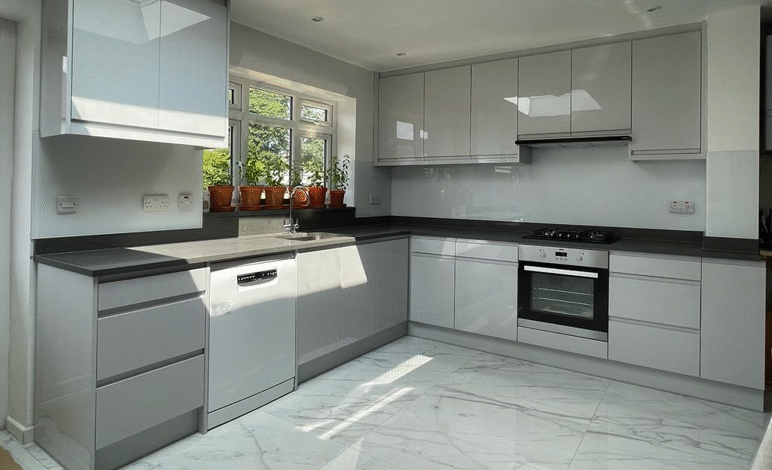What Determines the Cost of a Complete Kitchen Installation?

A kitchen is an essential part of any home or even office. It improves daily life, increases your living or work place value and helps you avoid costly surprises. Therefore, its proper installation is crucial to ensure efficient functionality and avoid frequent repairs and early replacement issues.
New kitchen installation is an expensive investment. It involves various costs, so knowing what shapes the final price is necessary to make smart decisions and keep the project on budget. In this guide, we will provide you with clear explanations of the main cost drivers, how each one affects the total expenses, and practical tips to control spending without sacrificing quality.
Materials Quality
Material types and quality set the baseline for cost. High-end doors, solid wood cabinets, thick stone worktops and premium sinks cost far more than mass-produced alternatives, but they are long-lasting and aesthetically more appealing. On the other hand, flat-pack units and laminate worktops reduce the upfront price but may need frequent replacement.
When comparing quotes, ask for exact material grades and samples, helping you know what you are paying for. Moreover, in cities, regional pricing also matters a lot. For example, a typical kitchen installation in Birmingham usually has different materials and delivery charges than elsewhere in the UK.
Labour Costs
Labour costs form a large part of the total. Skilled joiners, plumbers, electricians and plasterers each charge different hourly rates, and their time adds up. Moreover, for complex installations, you will need more specialist help and supervision, which also raises costs. Efficient scheduling cuts labour waste, but rushed projects with overlapping trades can result in premium charges.
Make sure that written quotes include all trades, snagging and final checks so there are no surprise bills. Additionally, check whether fitters provide guarantees for their work, because a longer warranty can justify a higher initial charge.
Size and Layout
The size and layout of the kitchen can strongly influence price. A compact galley kitchen uses fewer cabinets, shorter runs of worktop and less flooring than a large open-plan space, so the material and labour totals are naturally lower. Changing the layout, moving appliances, plumbing or gas lines, can also add to the total cost. On the other hand, an island requires additional floor and service planning and can add several thousand to the budget.
Measure your space accurately and decide whether a layout change is essential before committing to expensive alterations.
Appliances and Fixtures
Appliances and fixtures, such as premium ovens, integrated fridge freezers, induction hobs and dishwashers cost more up front, and also require specialist installation. Energy-efficient models may be expensive, but they reduce running costs and can also qualify for incentives or rebates.
Always check spare parts availability and warranty terms so future repairs don’t become expensive surprises. Additionally, include appliance make and model in quotes so you know whether installation and testing are included in the price.
Plumbing and Electrical Work
Considering the plumbing and electrical work can also help you determine the complexity and cost of the installation project. Moving sinks, waste pipes or adding new water feeds means cutting floors or walls and fitting extra pipework. Similarly, rewiring for additional sockets, underfloor heating, or extractor fans increases both labour and materials costs.
In areas like the UK, safety regulations require qualified electricians and plumbers and certificates on completion, influencing the total cost. Always insist on written certification for significant works to avoid liability and to support future resale value, and keep records for warranties.
Kitchen Design
When installing a new kitchen, most people overlook the design fees and project management costs. An experienced designer can help you create efficient storage, optimise workflow and help you avoid costly mistakes. Design drawings, 3D visuals and specification lists cost money but save time during ordering and installation. On the other hand, managing the project yourself can save on management fees, but you take on responsibility for sequencing and dealing with problems.
Structural Work
Structural work and building control requirements can raise the price significantly. Removing load-bearing walls, installing new windows, or altering foundations requires engineers’ input and council approvals. These steps add professional fees, more labour, and sometimes extended timelines. Even smaller changes like fitting a replacement window or enlarging doorways may trigger required notices or compliance work.
Get early advice from a structural professional if your plan affects the building fabric, so you can include these costs in your budget and avoid delays on site.
Your Home Location
Your kitchen location is also an important cost-influencing factor. Deliveries to tight streets, upper-floor flats or properties without parking can add haulage, parking fines and extra labour for carrying materials into the home. Similarly, regional supply affects lead times, such as some specialist goods may take longer to arrive in remote areas. Additionally, local labour rates also vary, and demand can push prices up during busy months.
When you compare installers, check travel and delivery charges. Search for local kitchen installation services in London carefully, and choose the one that suits both your needs and budget.
By considering all these factors, you can easily set a realistic budget and avoid unnecessary costs or hidden charges during the kitchen installation project



